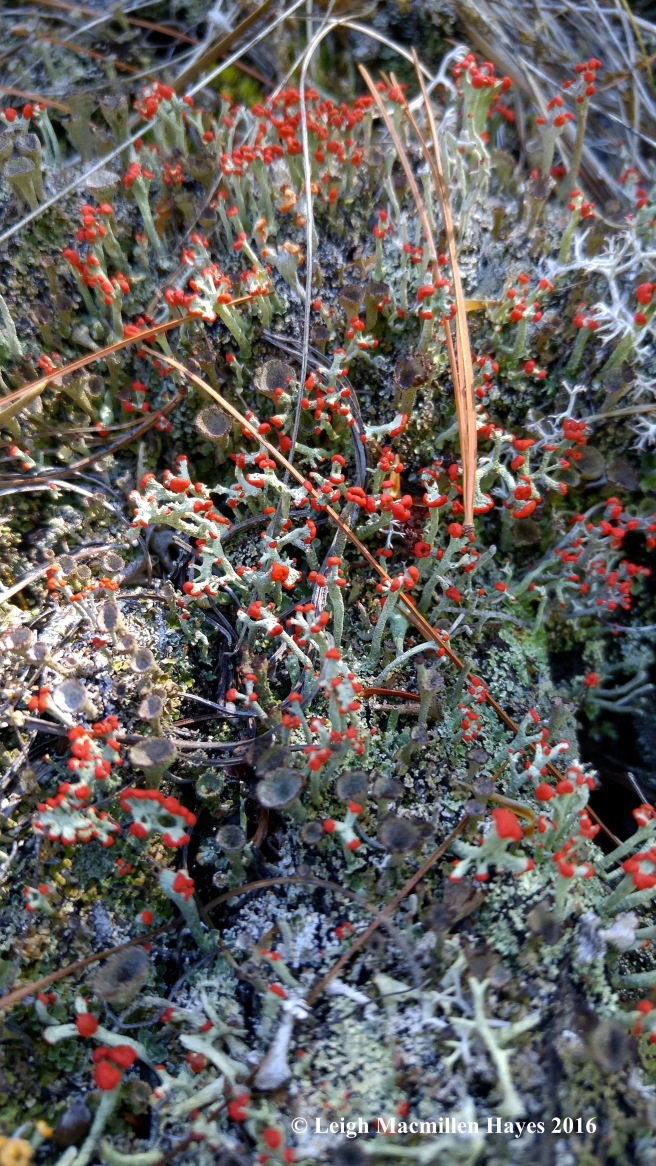When I invited Jinny Mae to join me at Loon Echo Land Trust’s Bald Pate Preserve this afternoon, she eagerly agreed. And three hours later, I know she had no regrets. Though we never reached the summit, neither of us cared. Our minds were boggled by all that we had noticed.

Somehow we managed to beeline our way to the Foster Pond Lookout. And then we slowed down. To a stop.

And so we got rather personal with the rock substrate as we took a closer look. At lichens. For what seemed like ever, it was thought that lichens were symbiotic life forms consisting of Freddy Fungus and Alice Algae, who took a liken to each other and their marriage formed a single organism. Sometimes, cyanobacteria or blue-green algae was tossed into the mix. The fungus provided shelter (algae can only live where they won’t dry out and so being surrounded by fungal cells meant Alice could live outside of water), while either of the photosynthetic partners, algae or cyanobacteria, produced food from the sun.
It’s no longer just a story about Freddy and Alice living together, however. New scientific research deems another partner in the mix–yeast, which also provides protection. I feel like just stating that puts me way out of my league.

Our goal wasn’t to understand those relationships per say. We just wanted to spend some time looking and developing an eye to recognize these structures while appreciating their life’s work that often goes unseen.

Some grow at an especially slow rate–think hundreds of years rather than decades. That in itself, should stop us in our tracks. And yet, as we stand 5+ feet above those that grow on rocks, we hardly notice them.

The dark brown fruiting bodies, called apothecia, are where spores are produced and life continues. Walk tenderly, my friends.

Jinny Mae’s excitement over the toad skin lichen was contagious. Notice its warty projections–much like the skin of an American toad, which varies in color.

I spied this toad a few days ago, but its skin certainly helps qualify the lichen’s common name.

If you look in the center, you can see the point where the lichen attached to the rock–the belly button of this particular lichen making it known as an umbilicate lichen.

And among the favorite finds of the day, Jinny Mae was the first to spy this. It had rained this morning and everything was dry by the time we hiked, but some signs of moisture remained. In this case, it’s wet toad skin contrasted by dry toad skin. If you are willing to give up some water from your water bottle, you can create the same contrast. And note the black dots–its fruiting bodies or apothecia where its spores are produced.

The more we looked, the more we saw.

British soldiers were topped by their brilliant red caps–forever announcing their presence.

Pixie-cup lichen stood like goblets, ready with magical potions.

Some were filled to the brim and almost overflowed with life.

We marveled at the green,

gray,

and foam-like structure of reindeer lichen. These are treats for reindeer and caribou, neither of which frequent our region except for one night a year.

And then we looked at the next layer in succession on a rock. Once the lichens have established themselves, mosses move in. Did you ever think about the fact that mosses don’t have flowers, stems or roots? Instead, they feature tiny green leaf-like structures and microscopic hair-like structures. They send their “hairs” into the crevices created by the lichens and anchor themselves to the rocks. Today, we found a moss neither of us remember seeing before.

To us, it offered a square presentation and we debated its identity. While we thought it may be yellow yarn moss, I’m now leaning toward medusa moss–though their leaf edges are smooth and these are obviously toothed. Do you know? Which ever it is, we were wowed.

We finally moved on, hiking to a false summit to take in the western view.

The late afternoon sun and breeze played havoc with our views, but we eventually reached the rock tripe wall, where common polypody took advantage of the living conditions.

The lichen covered a ledge, some of it green from the morning rain, but surprisingly much of it still brown. Like the toad skin lichen, rock tripe are umbilicate and attached to the rock at a single point. They reminded me of elephant ears flapping in the breeze.
From there, we headed down. Our pace on the slow side all afternoon.
And sometimes we had absolutely no pace at all, unless you consider the motion (and grunts) as we got down on our hands and knees and even our bellies to take a closer look. It was all worth a wonder. And we did.

Wow!
Faith sent from my Ipad
>
LikeLiked by 1 person
It was great fun.
LikeLike
wonderful photos – and writing!!
LikeLiked by 1 person
Thanks Linda. I need to spend more time looking. Ah . . .
LikeLike
Again learned a lot from the 2 of you. Ursula >
LikeLiked by 1 person
And Ursula, we all have so much more to learn. That’s the best part.
LikeLike
Thanks again, Leigh. You are a good teacher! We hiked Lord Hill on Friday, and I looked for your lessons.
LikeLiked by 1 person
My pleasure, Ann. So glad you hiked up Lord Hill and took me along 😉
LikeLike